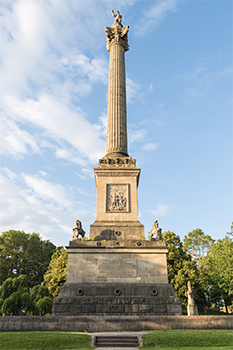
Battle of Queenston Heights 210th anniversary re-enactment event.
PC: Niagara Falls Tourism
The battle of Queenston Heights
On a dark October day in 1812, a small force of British defenders, outnumbered six to one, met a larger American army in the first battle for the Niagara frontier. Queenston Heights was designated as a site of national importance in commemorating this battle, the men who were lost, and the impact it had on the course of the War of 1812 in determining Canada’s future.
On October 13th, 1812, under the leadership of Major-General Stephen Van Rensselaer, members of the US Regular Army and militia units crossed the Niagara River, and the battle of Queenston Heights began. The Americans were initially successful in gaining control of the Heights above Queenston village.
Major-General Isaac Brock hurried from Fort George to the village and quickly assembled a small band of 49th Regiment soldiers and militia, leading them to confront the American invaders and regain the Heights.
Expecting a counter attack, the Americans began to fire on the British. Brock, who was leading the charge, was killed. While British forces waited for reinforcements, Native Warriors under the leadership of John Norton climbed the Heights and harassed the American forces, keeping them contained. British regulars from Fort George and Chippewa arrived that afternoon and fought alongside the Native Warriors, Canadian Militia, and Runchey’s Corps of free black men, eventually forcing a surrender and taking 958 American prisoners. This victory ended the American offensive of 1812 and, coupled with recent victories at Fort Mackinac and Fort Detroit, helped to unify the population behind the war effort.
There were relatively few casualties for the British side, though the loss of Brock was considerable. The others lost that day include Lieutenant-Colonel John Macdonell; Sergeant Charles Merryweather, Privates Thomas Haynes and David Jones of the Forty-First Regiment of Foot; Privates Richard Frickleton, Thomas Gee, Martin Hall, Thomas Levins, John Merrick, William Newman, John Smith and Richard Wade of the Forty-Ninth Regiment of Foot; Private Henry Cope of the Second Regiment of York Militia; Private Thomas Smith of the Third Regiment of York Militia; Ayanete and Kayentatirhon, Cayuga Chiefs; Ta Kanentye, Onodaga Warrior; and Kayarawagor and Sakangonguquate, Oneida Warriors;
Major-General Isaac Brock and his Aide-de-Camp Lieutenant-Colonel John Macdonell are buried and commemorated in Brock’s Monument, built where the climax of the battle took place.
Major-General Sir Isaac Brock

Major-General Sir Isaac Brock is widely promoted as a hero in Canadian history, and yet most only remember he led a charge at the Battle of Queenston Heights, which resulted in his death.
There is more to this story.
The War of 1812 was declared by President Madison on June 18, 1812. To the residents of Upper and Lower Canada, as well as the meagre 6,000 British regulars stretched from Halifax to Fort St. Joseph, this was not good news. British leaders had hope that when reports reached Washington of the unpopular Orders in Council being repealed on June 23, conflict would cease. This did not happen. Brock and his superior, Governor George Prevost, differed greatly on defensive strategy. In this case, Brock argued for offense being the best defense. The reason he largely became known as a hero at the time was due to the successful captures of Forts Mackinac and Detroit by mid-August 1812. This was possible thanks to Brock’s own skill and initiative, as well as his rapport with Tecumseh, John Norton and Joseph Brant. Their respect made Brock a war chief in the eyes of most Indigenous warriors, reinforcing invaluable allies early on in the war.
Brock had the ability to balance his knowledge of war strategy with bureaucracy as he retained the loyalty of the Executive and Legislative Councils in the face of mounting numbers of American late loyalists. He also was the bulwark of the local Niagara militia, forming well-trained flank companies to assist the army, which helped to inspire more admiration.
It is true Brock’s cavalier attitude contributed to his death at the Battle of Queenston Heights. However, the decision to charge up the heights was not as self-motivated as often described in literature, images and song. As a qualified Major-General, Brock would have made an assessment and weighed his options before taking any action. He knew all his experienced senior officers were seriously wounded and was likely aware that it was the last chance to curb the American advantage while British forces contained American soldiers at the beach landing.
The American position on the heights was tenuous. Brock's 'heroic' charge was the catalyst within the battle for the subsequent push from John Norton along with Lieutenant-Colonel John Macdonell (Brock’s aide-de camp), and later Captain Holcroft of the Royal Artillery and Captain Derenzy’s 41st Light Infantry. These units were able to contain the American forces until reinforcements could arrive from Fort George.
Had the Americans claimed victory at the heights, the entire western portion of Upper Canada would have been under threat. It would have forced the British to abandon Niagara, leave the Detroit frontier isolated and jeopardize the security of York, Georgian Bay and the Upper Great Lakes. The majority of the British army would have retreated to Kingston in preparation of abandoning the colony.
Yet, the Battle of Queenston Heights was a British victory. This achievement, following soon after the captures of Forts Mackinac and Detroit, gave the loyal population hope that the British war effort might triumph, despite the vast disparity in available troops between them and the Americans. Despite suffering the loss of Major-General Sir Isaac Brock, the people had time to get organized and build up confidence - the colony could be defended.
- Date modified :